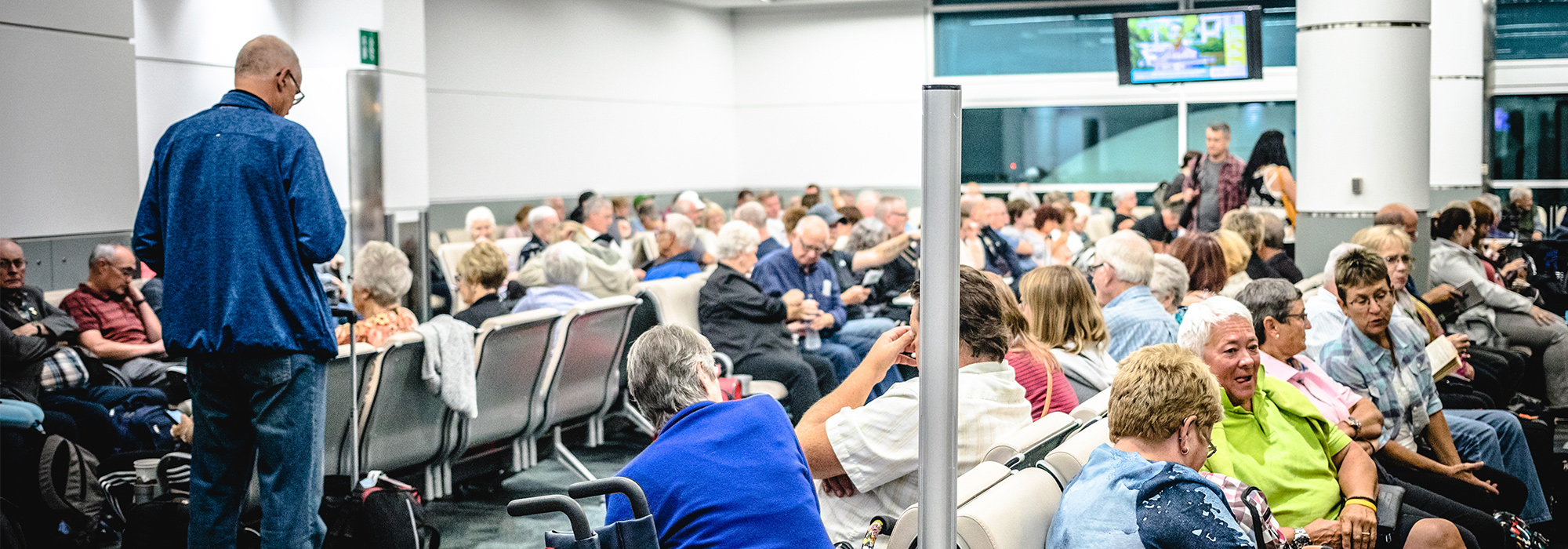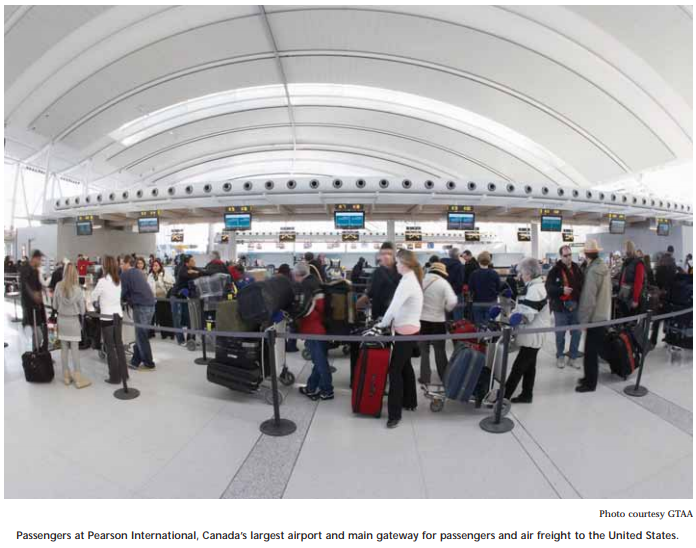
Canada and the United States enjoy an economic relationship, and both countries are by far each other’s largest trading partner. Canada and the US have been working on the Beyond the Border initiative — to transcend certain current obstacles to trade between our two countries, smooth some common security concerns and harness the mutual economic opportunities of greater trade integration.
Referred to as the “Perimeter Security” discussions in the shorthand of the public policy community, this initiative has generated the usual criticisms and questions — most notably involving privacy and a potential of ceding sovereignty to the US government. These concerns notwithstanding, Canada and the US will continue to be economically intertwined in the future. Recent fiscal and economic challenges in the US have renewed calls for greater diversification of our export market, but Brazil, India and China will never take the place of the United States as a market for Canadian exports, and as an engine of Canadian economic growth.
So reality brings us back to the original premise underlying the Beyond the Border initiative: What practical steps can we take as two countries to greater facilitate a free exchange of trade and people for the mutual benefit of both economies?
The traditional paradigm has been the assumption that Canadian policy is concerned with trade first and foremost, while security concerns trump trade in the United States. But recent years have revealed a shift in approach in both countries: the fiscal and economic realities facing the United States today are such that Americans can no longer afford to have economic considerations play a distant second place to security concerns. Conversely, the Canadian government has shown a greater receptiveness in recent years to US security sensitivities and has signalled a greater willingness to engage our southern neighbours on practical security issues.
These two factors have led to a greater convergence of policy approach, with both countries now handling the relationship in a more balanced manner, capable of evaluating policy through the other country’s “traditional” lens. If ever there were a climate for a productive and earnest dialogue on trade and security, that time is now.
The current discussions between Canada and the United States on the concept of perimeter security, as led by Prime Minister Harper and President Obama, lead us to consider a broad range of trade and security issues across the 49th parallel. Indeed, this current focus is long overdue but, if approached from a broad-minded yet realistic perspective, may lead to genuine improved economic opportunities, while preserving the national priorities of each nation.
Often lost in the discussion of transborder trade is the crucial role played by aviation. Discussions of commercial traffic across the border tends to focus on the “rubber” traffic — trucks and trains taking produce, products and goods to markets in each country. Indeed, one’s mind can quickly and easily conjure images of 18-wheel trucks in long queues waiting to be processed at the dozens of major border crossings across our continent. But we need to think beyond this archipelago of booths dotting the 49th, and consider the full, integrated and sophisticated network of facilities that make up our true Canada-US border — and that means recognizing the importance of airports as ports of entry, exit and commerce.
Through the technology of aviation and the policy foresight of preclearance, cities and towns that were once distant concepts are now immediate neighbours.
Through millions of sales trips, tourist visits and journeys to visit relatives, aviation is contributing to the economic integration of the North American continent in a way that the “rubber traffic” can never hope to do. A several-hour journey between our two markets — any two points on either side of the border — has become a regular and common journey, undertaken by millions of people every year.
From the perspective of the supply chain, which sees Canadian manufactured goods sold in American stores, often the first physical interaction between the two markets is done by air. And as we have watched the manufacturing base of North America decline under cheaper off-shore alternatives, we are seeing the rise in importance of what pre-eminent urban thinker and academic Richard Florida has called the “creative class” and the service industry. This economic sector increasingly relies upon the ability to be mobile — at a moment’s notice — to access sales meetings, design conferences, legal symposiums and countless other interactions in farflung destinations across the continent. That ability starts and ends at the airport and relies on the processes undertaken at that facility. To underscore the point of the importance of airports and aviation, Richard Florida has noted:
Understanding that the airport is one of the most strategic decisions a community can make for its future is critical. The airport has to be seen in the broad development of a creative economic strategy.
Thousands of jobs and billions of dollars of economic prosperity are dependent upon air access. As Canada’s largest air hub, Toronto Pearson provides direct air service to 46 American cities and ranks number one among international airports feeding passengers into the US market. Our airport alone handles more than 400,000 flights and 32 million guests annually — in other words, the equivalent of the entire population of Canada passes through our gates every year, with roughly 10 million travelling between Canada and the US annually.
If we understand the economic value of air travel, we also have to speak of the current economic and political context in which this travel occurs. This context, I would argue, is characterized by the following factors: NAFTA has proven to be an enormous success, leading to the integration of the Canadian and American economies in a manner that is irreversible. Canada is the leading trade partner of 35 of the 50 American states and is either second or third for the balance. In addition, it is not simply the northern border states that depend upon Canadian trade; critical symbiotic trade links exist between Canada and even the deep south — a region less serviceable for trade purposes by land transport.
At the same time, we cannot deny the emergence of the BRIC countries — the faster-developing and immensely populous bloc of Brazil, Russia, India and China — and the potential that they present for Canadian bilateral trade. But what is striking about the emergence of the BRIC is that North America as an integrated economic geo-polity finds itself in competition with other regions of the globe for investment, trade and dialogue with the BRIC. Neither Canada nor the US is well served if we take the approach of competing with each other for the emerging BRIC spoils. Conversely, cooperation on an integrated North American basis — and building on the strength of NAFTA — provides an integrated North American economic bloc with the synergies that allow maximum economic and trade benefits for both North American partners.
NAFTA has proven to be an enormous success, leading to the integration of the Canadian and American economies in a manner that is irreversible. Canada is the leading trade partner of 35 of the 50 American states and is either second or third for the balance.
Finally, any discussion of the current economic and political reality is not complete without a realistic discussion of the fiscal challenges now faced by all countries. The recession of 2008, coupled with continuing fiscal uncertainties in many regions of the globe, means we cannot ignore the fact that governments will be asked to do more with less. It would be wrongminded, however, to ignore the opportunities presented by fiscal constraints, as they can lead to creative solutions, new approaches and startling innovations. Far from shying away from the fiscal constraint, we must embrace it and the “smart” policy-making — lean, cost-effective and impactful solutions — that the current fiscal climate engenders.
So given the context of North American economic integration, emerging global economic significance of populous new markets and fiscal pressures within North America, what are the concrete policy options we can pursue to ensure we positively harness the potential of aviation as a major economic generator and trade facilitator?
Can we actually use tools such as border inspection services — in both our countries — as tools of economic development? Can customs, immigration and security imperatives be not merely addressed for current inadequacies, but enhanced in ways that do not impinge upon the daily torrent of north-south commercial activity? Can they be improved to promote even greater flow of people, goods and capital between Canada and the US?
- I would argue this is all possible. With creativity, a broad-minded approach to public policy and political will, I will propose six policy initiatives that would allow transborder aviation to reinforce North America’s global economic position:
- Expressly recognizing the value of aviation in the context of transborder trade, and developing the concept of the Gateway Airport;
- Staffing air border ports at a sustainable level;
- Investing in technological solutions to streamline the air border;
- Examining all aspects of current border processes, and leaving no “sacred cows” unaddressed;
- Implementing a risk-based approach to security; and
- Engaging in a serious effort to jointly plan an integrated North American transportation infrastructure network.
Policy-makers on both sides of the border must formally recognize the value that aviation plays in the economies of both nations. The Beyond the Border discussion must definitively and permanently break beyond the narrow confines of the land border for a sophisticated approach to policymaking. The first step is to solidify in policy-makers’ minds the direct relationship between aviation and economic growth. Only then will government start to naturally and instinctively appreciate the concept of the Gateway Airport as an economic engine.
The federal Blue Skies policy of expanding bilateral air service is another positive sign that the Gateway Airport concept is being taken seriously. This approach must be continued. Increased attention among policymakers to the Gateway City concept is encouraging and reveals the positive lessons of London and New York City being evaluated within the public policy community in Canada.
We have seen a number of policy innovations over the years that have served us well — from the introduction of US customs pre-clearance to the introduction of the Nexus program and trusted traveller screening. That said, we are still doing an inadequate job as a sector in realizing the potential presented by new technology to improve the flow of traffic across the border while addressing issues of both customer service and security and interdiction. Technology is the single greatest opportunity in this area, but it requires all in the industry to have the will to succeed.
At present, programs such as Nexus and Global Entry do not have the penetration and capability to significantly improve the processing of travellers. The entire system — from enrollment, through kiosks, servers and other infrastructure support — is inadequate to meet the volume of today’s traffic, let alone to pave the way for growth.
Toronto Pearson is Canada’s largest entry point into the United States, and the fifth-largest US Customs and Border Protection port, but it has only six Nexus kiosks to serve the nearly 10 million passengers travelling to and from the United States. Moreover, merely augmenting the number of kiosks is not the solution; we need to increase the supporting infrastructure as well as the enrollment capability. In short, we need to approach the expansion of Nexus and Global Entry in the same manner the banks embraced the introduction of the ATM.
And this is just the beginning. So far we are talking about up-take of last year’s solutions. But what opportunities are presented by smart phones and other mobile technology? Can we use these devices to inform and equip passengers and border-crossing citizens as they travel, resulting in quicker processing times, better-prepared travellers and improved customer experience? How will technology assist us when, in just a few short years, the dominant languages in North America’s international airports will be Cantonese, Mandarin, Spanish and Portuguese? How will back-of-house technological solutions drive process improvements in both security and interdiction?
Technology will often drive changes that are uncomfortable to some. Technology may fundamentally change the way border inspectors work. There are considerable and important privacy concerns to be addressed. And in this fiscal climate, we must be mindful that cost issues be factored into any decisions. But we have to turn these concerns into opportunities. We have to have those concerns change the culture of how we approach inspection and security issues at our borders. For without technology, we will not be able to harness the potential that future integration will bring.
Technology is certainly a piece of the puzzle, but we can never fully replace the role that the inspector, the immigration agent and the security specialist play in operating our borders in an efficient manner. It is these individuals who search the bag, interview the Nexus applicant and run and develop the infrastructure that is required to handle the millions who fly from place to place across North America.
But it is also these individuals who represent the biggest cost to the system. Therefore it is incumbent upon us to ensure that staffing is deployed in the most efficient manner — that border and security staff be remunerated in an appropriate way, and that they are trained in the best methods possible. This will be especially true if technology becomes more important to the overall border-crossing experience. Will individuals have to be retrained and put into new positions? Will we have to assess where we deploy officers? Absolutely.
Many if the improvements to transborder processing will come from re-examining the manner in which passengers and their bags are inspected at each stage of a journey. While this may be the least glamourous aspect of the policy discussion, we can ill afford to ignore a discussion of process improvements.
Why must a passenger catching a connection be rescreened through security, adding to the lines of passengers waiting to be screened for a first time? Why must a passenger who is merely transiting a country en route to a third destination be screened by the host nation? Why do passengers have to be in physical possession of all their luggage to be screened for a connection? Can we harmonize security processing on both sides of the border to improve processing rates and achieve efficiencies? What role can each part of the airport community play in assisting this process — from the air carrier to the airport operator to the inspection agency, even to the cleaning staff?
Without a comprehensive review of processes including creativity and a “common sense check,” we can be assured that we will leave options unexplored with potential improvements unfulfilled. From a policy perspective this may lack the pulse and the zest of technological improvements, but we must allocate serious attention, resources, commitment and zeal to process improvements to realize the potential presented to us.
We must engage in an open and honest discussion about the role that risk assessment plays in our approach to processing transborder passengers.
Not all passengers, not all flights and not all destinations are equal from a security and interdiction perspective. For example, a weekly flight from Lahore or Lagos surely poses a different potential security interest than the thrice-daily flight from Allentown to Toronto. Similarly, the Bank of Montreal employee who travels four times a month from Toronto to Milwaukee to work on the Harris Bank merger presents an entirely different threat profile than a previously unregistered traveller on a route from a known global hot spot. We must have the maturity to acknowledge these facts and to allow our security agencies the flexibility to adjust their resources and approaches accordingly.
To be sure, we would not call for the gutting of current interdiction and inspection processes for the Toronto-Milwaukee business flight or its equivalent, but a risk-based assessment of the threat posed by these flights, and a matching application of technology and process improvements, could bring efficiencies commensurate with the economic importance and security threat of the voyage.
The decision to discuss a risk-based approach to border issues may give rise to any number of politically charged myths. If we ascribe the value to aviation that we argue exists, and if we embrace the potential of improvements to wring even better results from this transportation asset, then we collectively must have the courage to engage in a risk-based approach without fear and without conjecture.
Finally, we need to look at the planning of our aviation infrastructure on a continental basis. The native peoples and the early explorers of North
America knew no borders — simply the waterways that brought them deeper and closer to the wealth of the continent. Ironically, through prescient economic and trade policy, the border is becoming, if not irrelevant, then less important as a traditional defensive bulwark. If we engage in the five previous discussions, then the role of the border will continue to evolve, and perhaps lessen in importance.
If this is indeed the case, then surely we must discuss joint planning of a continental aviation infrastructure to complement a continental economy.
Not all passengers, not all flights and not all destinations are equal from a security and interdiction perspective. For example, a weekly flight from Lahore or Lagos surely poses a different potential security interest than the thrice-daily flight from Allentown to Toronto.
If the issue of interdiction and inspection across the border can become less of an issue through a comprehensive re-examining of our collaborative security regime as originally envisioned by the Beyond the Border initiative, can we then discuss where it would make the best sense to locate and develop airport infrastructure from a continental North American perspective? Do we need to build new airports and redevelop others at massive cost, when we can easily augment the capacity of other existing ones more efficiently on the other side of the border? We have the information and know-how to treat our entire airports system as a single organism. We can move toward infrastructure planning in the same manner — sophisticated, holistic and continental, as opposed to local, short-sighted and regionally competitive. With effort and will, we can maximize potential, focus resources and allocate risk in a manner that best reflects continental economic needs.
It may seem unreasonable — even audacious — to draw a parallel between continental economic prosperity and the prosaic world of the air passenger and his or her journey. After all, as residents of our shared North American continent, we make our everyday voyages between Toronto, Ontario, and Montclair, New Jersey, or between Vancouver, BC, and Boise, Idaho, and quietly suffer the hassle, indignities and inefficiencies of transborder inspections. We sigh, shuffle through another line and submit ourselves to the processes. And indeed, we do it in increasing numbers.
But we also do so heedless of the additional costs, additional burden and lost opportunities of antiquated policy and process. While the individual traveller can be excused for not appreciating these liabilities, there is little excuse for those crafting public policy in trade, transport and security. We hope this is changing. We applaud the efforts of our two countries and their leaders to launch the Beyond the Border initiative and look forward to the conclusion and initiation of the upcoming Action Plan. We urge that these discussions realize the tremendous opportunities of greater cooperation and trade integration between our two countries within what is already a single economy. We hope also that this opportunity be realized to modernize the way we think about and approach air transport — that we may see the creativity and maturity to rethink the ways in which we move people and goods between our two countries over our common —and friendly — skies.
Photo: Benoit Daoust / Shutterstock








